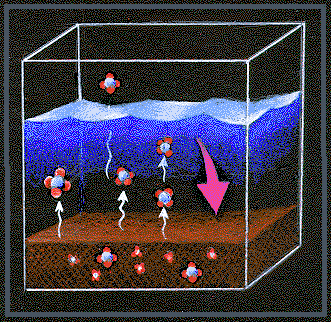
![]()
CROSSING A CLIMATE THRESHHOLD

Another Gas Attack

As ocean water warmed (arrow) methane molecules escaped from the sediment.
Another idea, suggest Jerry Dickens and Jim O'Neil of the University of Michigan, is that as the deep waters warmed from 11 degrees Celsius to 15 degrees Celsius, they unleashed powerful greenhouse gases.
Large amounts of methane could have seeped up through the sediments into the ocean, suggests Dickens, a graduate student in geochemistry. If the methane escaped into the atmosphere, it could have caused significant warming over tens to hundreds of years. That warming might have triggered the release of even more methane, heating the climate out of control. But until geologists figure out how to measure past levels of methane, Dickens' idea will remain untested.
Today, methane is trapped in tiny pores between sand grains off continental shores. Bacteria produce the methane as waste when they consume organic matter. Cages of water molecules surround the methane gas, making it a gray, ice-like solid called a hydrate. Could it melt?

